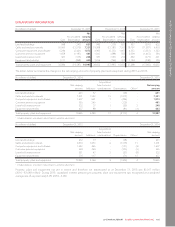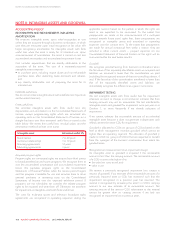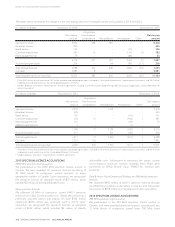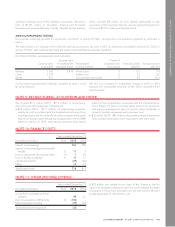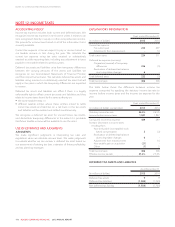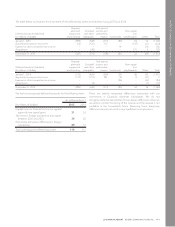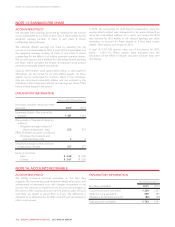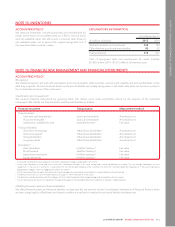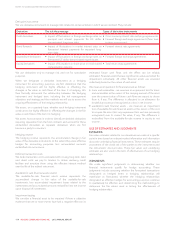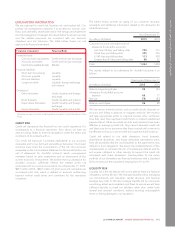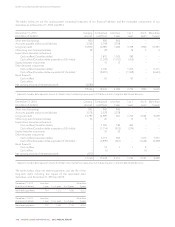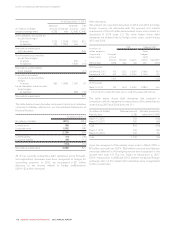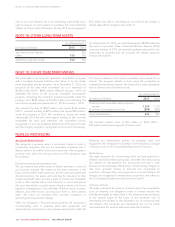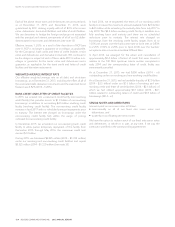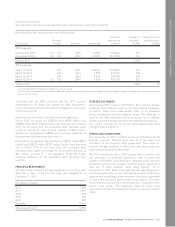Rogers 2015 Annual Report Download - page 117
Download and view the complete annual report
Please find page 117 of the 2015 Rogers annual report below. You can navigate through the pages in the report by either clicking on the pages listed below, or by using the keyword search tool below to find specific information within the annual report.
NOTES TO CONSOLIDATED FINANCIAL STATEMENTS
EXPLANATORY INFORMATION
We are exposed to credit risk, liquidity risk, and market risk. Our
primary risk management objective is to protect our income, cash
flows, and ultimately, shareholder value. We design and implement
the risk management strategies discussed below to ensure our risks
and the related exposures are consistent with our business
objectives and risk tolerance. The table below shows our risk
exposure by financial instrument.
Financial instrument Financial Risks
Financial assets
Cash and cash equivalents Credit and foreign exchange
Accounts receivable Credit and foreign exchange
Investments, available-for-sale Market
Financial liabilities
Short-term borrowings Liquidity
Accounts payable Liquidity
Accrued liabilities Liquidity
Long-term debt Liquidity, foreign exchange
and interest
Derivatives 1
Debt derivatives Credit, liquidity and foreign
exchange
Bond forwards Credit, liquidity and interest
Expenditure derivatives Credit, liquidity and foreign
exchange
Equity derivatives Credit, liquidity and market
1Derivatives can be in an asset or liability position at a point in time historically or in the
future.
CREDIT RISK
Credit risk represents the financial loss we could experience if a
counterparty to a financial instrument, from whom we have an
amount owing, failed to meet its obligations under the terms and
conditions of its contracts with us.
Our credit risk exposure is primarily attributable to our accounts
receivable and to our debt and expenditure derivatives. Our broad
customer base limits the concentration of this risk. Our accounts
receivable on the Consolidated Statements of Financial Position are
net of allowances for doubtful accounts, which management
estimates based on prior experience and an assessment of the
current economic environment. We believe that our allowance for
doubtful accounts sufficiently reflects the related credit risk
associated with our accounts receivable. As at December 31, 2015,
$461 million (2014 – $461 million) of gross accounts receivable are
considered past due, which is defined as amounts outstanding
beyond normal credit terms and conditions for the respective
customers.
The tables below provide an aging of our customer accounts
receivable and additional information related to the allowance for
doubtful accounts.
As at December 31
(In millions of dollars) 2015 2014
Customer accounts receivables (net of
allowance for doubtful accounts)
Less than 30 days past billing date 759 713
30-60 days past billing date 305 326
61-90 days past billing date 113 108
Greater than 90 days past billing date 66 62
Total 1,243 1,209
The activity related to our allowance for doubtful accounts is as
follows:
Years ended December 31
(In millions of dollars) 2015 2014
Balance, beginning of year 98 104
Allowance for doubtful accounts
expense 66 77
Net use (78) (83)
Balance, end of year 86 98
We use various internal controls, such as credit checks, deposits on
account, and billing in advance, to mitigate credit risk. We monitor
and take appropriate action to suspend services when customers
have fully used their approved credit limits or violated established
payment terms. While our credit controls and processes have been
effective in managing credit risk, they cannot eliminate credit risk
and there can be no assurance that these controls will continue to
be effective or that our current credit loss experience will continue.
Credit risk related to our debt derivatives, bond forwards,
expenditure derivatives, and equity derivatives (derivatives) arises
from the possibility that the counterparties to the agreements may
default on their obligations. We assess the creditworthiness of the
counterparties to minimize the risk of counterparty default, and do
not require collateral or other security to support the credit risk
associated with these derivatives. Counterparties to the entire
portfolio of our derivatives are financial institutions with a Standard
& Poor’s rating (or the equivalent) ranging from A+ to AA-.
LIQUIDITY RISK
Liquidity risk is the risk that we will not be able to meet our financial
obligations as they fall due. We manage liquidity risk by managing
our commitments and maturities, capital structure, and financial
leverage (see note 3). We also manage liquidity risk by continually
monitoring actual and projected cash flows to ensure we will have
sufficient liquidity to meet our liabilities when due, under both
normal and stressed conditions, without incurring unacceptable
losses or risking damage to our reputation.
2015 ANNUAL REPORT ROGERS COMMUNICATIONS INC. 115


